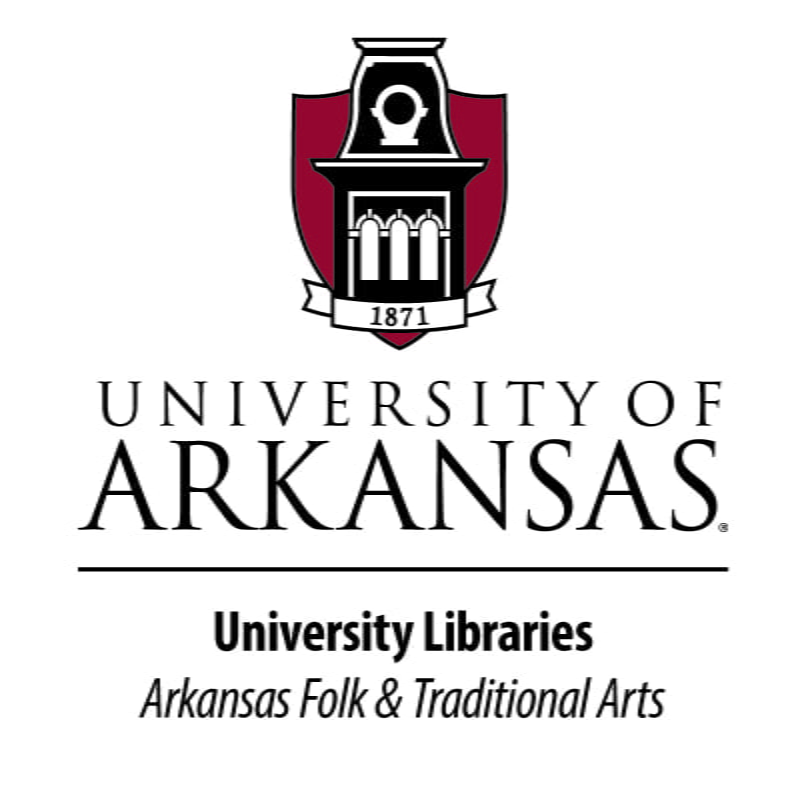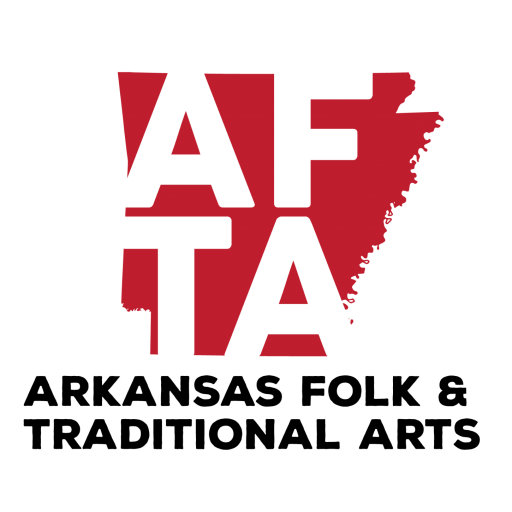About Arkansas Folk and Traditional Arts
Arkansas Folk and Traditional Arts (AFTA) is a department of University of Arkansas Libraries Special Collections Division dedicated to the land grant mission of the University of Arkansas. AFTA’s work is supported, in part, by grants from the Arkansas Arts Council and National Endowment for the Arts and working in partnership with stakeholder organizations and individuals, such as Arkansas State University and Mid-America Arts Alliance.
While AFTA in its present form was founded in 2019, the mission and initiative itself is not new to Arkansas. AFTA builds on the existing legacy of folk and traditional arts programming built initially by the Arkansas Arts Council. This work was continued through the Texarkana Regional Arts & Humanities Council, and then later, the Arkansas Folklife Program located at Arkansas State University. Arkansas Folk and Traditional Arts honors the hard work and fieldwork built by its partners and predecessors.

Mission
Founded in 2019, AFTA’s work continues to evolve and mature as programming is developed. AFTA’s guiding mission as it grows is as follows:
AFTA is dedicated to documenting, presenting, and sustaining Arkansas’ living traditional arts and folklife. AFTA develops and supports projects and programming in collaboration with Arkansas citizens, with an emphasis on including rural and underrepresented artistic traditions.
AFTA’s three points of focus (click each to learn more):
Document
AFTA conducts regular fieldwork to document Arkansas traditions and tradition-bearers. Fieldwork most often takes the form of oral history interviews, photographs, and other audio/video recordings depending on the circumstances and wishes of collaborators. Fieldwork may be used for programming and publications, but a “product” of fieldwork collected is not necessary. Contributing to and growing documentation of Arkansas folk and traditional arts is a goal in and of itself.
Present
AFTA partners with organizations and individual collaborators to offer or support public programming centered on Arkansas folk and traditional arts. Public programs include lectures, workshops, exhibits, demonstrations, festivals, educational curriculum, and more. AFTA strives to ensure that programming is open to the general public and both physically and economically accessible.
Sustain
Whether fieldwork or public programming, the heart of AFTA’s work is sustaining and supporting Arkansas tradition-bearers to ensure that Arkansas folk and traditional arts can thrive for communities across the state. AFTA aims to provide resources and programming that offer support, skills, and training for citizens involved in documenting or practicing Arkansas traditions.
Defining Folk and Traditional Arts
Throughout this website and in AFTA’s publications and programming, you may see and hear several terms that appear similar:
Folk Art
Traditional Art
Folklore
Folklife
Tradition
AFTA staff belong to a society of folklorists who study folklore in the academic and/or public sector. The definition of folklore and its related terminology has a long and complex history. Though folklorists agree on the components of the definition, the term “folklore” has been difficult to define succinctly. The American Folklore Society has compiled a list of these varied definitions created and shared by folklorists over the years in the article, “What is Folklore?”. William M. Clements, in the introduction to An Arkansas Folklore Sourcebook, devotes large portions of the chapter to discussing the topic, but perhaps simplifies it best by writing that, “folklorists study unofficial culture.”
Folk art and traditional art, an important part of the study of folklore, can be used interchangeably to discuss traditions that are artfully and skillfully executed and communicated within communities. Folk and traditional arts could be seen as one component of a broader term, “folklife,” which serves to encompass the idea of folk arts (often seen to include only material traditions) with other intangible aspects, such as beliefs, customs, legends (inmaterial traditions).
Arkansas Folk and Traditional Arts takes a broad approach to studying and sustaining traditions throughout the state and may use the word “folklife” in programming and publications. Intangible traditions can also be considered artforms (such as storytelling) and often intangible traditions are intertwined with tangible forms of material culture.
For Arkansas Folk and Traditional Arts, Folk and Traditional Arts are:
- Rooted in Communities: Traditional arts exist in communities, which can include families, geographic regions, religious groups, clubs, schools, and more. Some folklorists call these different communities “folk groups.”
- Learned in Communities: Traditional arts are passed down and learned between members of communities, though new generations may add their unique twist to the tradition. Those individuals who practice and share their traditions are called “tradition-bearers.”
- New and Emerging: Traditions evolve and change. Communities create new traditions all the time, including new foods, events, festivals, sayings, jokes, rituals, and more.
- Diverse Yet Universal: Many communities thrive across the State of Arkansas yet all have their own traditions and traditional arts that are a part of the heritage and unique story of Arkansas.
Frequently Asked Questions
What is a public folklore / folk art program?
Arkansas Folk and Traditional Arts belongs to a network of public folklore programs across the United States, though public folklore programs may be housed in various organizations and agencies, from arts council and humanities councils to nonprofits and universities.
From the American Folklore Society’s Public Folklore Section:
“‘Public folklorists’ work primarily in government or non-profit arts, cultural, or educational organizations, such as arts councils, historical societies, libraries, museums, or organizations devoted specifically to folk arts or folklore. Public folklorists are engaged in a variety of activities, including (but not limited to) field research and documentary work, and the production of public programs or educational materials, such as performances, artists’ residencies, exhibitions, festivals, sound recordings, radio and television programs, films, videos, and books.
This mix of occupational home base and audiences has characterized the Society’s membership from the start. In 1888, the Society’s founding group included writers (Mark Twain was one of our founders), private men and women of learning, and museum professionals, as well as university-based scholars. But since 1970, “public folklore” has grown and developed very rapidly in the United States. At the time of this writing, about half of the American Folklore Society’s members identify themselves as public folklorists. However, it is important to remember that many folklorists work (or have worked) both in universities and in public folklore, and the two parts of the field are intimately connected. Universities, for example, are where most folklorists are trained in the ways of our field, and the public side of folklore work connects to general audiences in ways that increase appreciation for the field as a whole.”
For a list of public folklore programs in the United States, visit the American Folklore Society’s directory (external link opens in new window).
The history of public folklore programs in the United States owes a great debt to Bess Lomax Hawes, who made it part of her life’s work to establish a network of folklorists doing this work across the country. Learn more by reading about her legacy on Smithsonian Folklife’s website (external link opens in new window).
What is a state folklorist?
Arkansas Folk and Traditional Arts, you may sometimes hear the director of Arkansas Folk and Traditional Arts referred to as the “state folklorist” of Arkansas. What does this mean?
The title of “state folklorist” is a legacy of the original proposed framework of state folklore/folk art programs championed by Bess Lomax Hawes, the first director of folk and traditional arts at the National Endowment for the Arts. Hawes (of the famous family of John and Alan Lomax) envisioned a state folklorist embedded in every arts council across the nation. In reality, and for a variety of practical reasons, her vision was never fully realized; there are many arts councils with embedded folk arts programs and, following Hawes’ model, many public folklorists in these positions took on the title of state folklorist. However, there were many other states where the state folk arts program developed outside arts councils—in humanities councils, non-profits, universities, etc. Regardless of home, every folk arts program fulfilled a shared mission to document, present, and conserve their state’s folklore. Many of these programs, too, worked in direct partnership with their state arts councils to do this work.
Over the decades, the title has been critiqued by many folklorists in the discipline. One common critique is that it implies that there is only one person doing this important work in each state. Some have instead decided to style themselves as “a” state folklorist to remind audiences that they are one of many experts in the region. A second critique is that the title is misleading: state folklorist implies an all-encompassing knowledge of the state’s folklore, when, in reality, the position is more about bringing resources to communities across the state who are the experts of their own traditions.
While the title is slowly phasing out of use, it remains part of the vocabulary of folk arts infrastructure throughout the nation, and so it is common to see others referring to our director as the “state folklorist.” Please note that AFTA seldom uses this term, except in settings where the context and distinction is appropriate (such as a gathering of all the state folk art directors in the nation).




